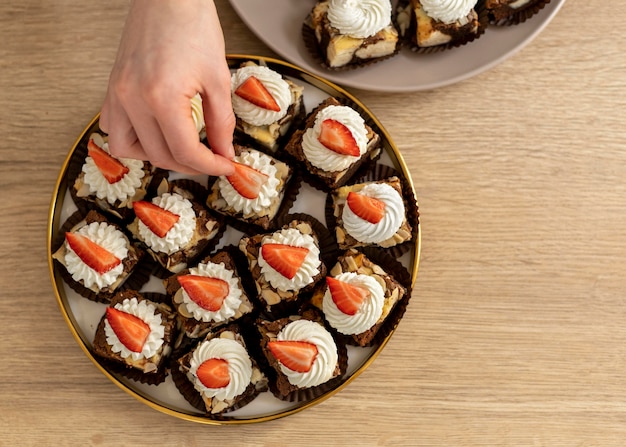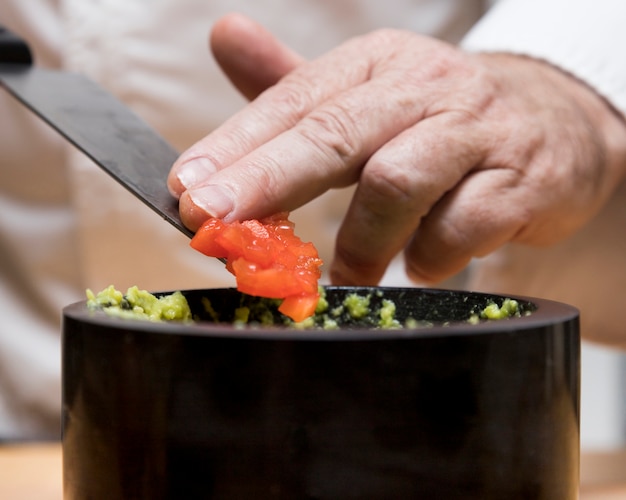Let's talk sushi rice. You know, the kind you find in those fancy restaurants, perfectly sticky and glistening, the perfect canvas for your favourite toppings. For years, I thought making sushi rice at home was some kind of culinary magic trick, something only professional chefs could pull off. But then, one sunny afternoon, I decided to give it a go. And guess what? It wasn't rocket science! In fact, it was surprisingly easy.
This is going to be your guide to perfect stovetop sushi rice, even if you've never cooked a single grain of rice before. Don't worry, I'll walk you through every step. We'll cover everything from choosing the right rice to achieving that perfect texture. So grab your chopsticks, put on your apron, and let's get cooking!
(Part 1) The Right Rice: The Foundation of Great Sushi

Choosing the Right Rice
The first step is choosing the right rice. It's not just any rice that will do; you want Japanese short-grain rice. This particular type of rice has a high starch content, which is what gives it that unique stickiness, perfect for making sushi. Trust me, there's a world of difference between just any rice and the real deal when it comes to sushi.
Types of Japanese Short-Grain Rice
You'll find a few different varieties of Japanese short-grain rice. Don't let the choices overwhelm you; they all work beautifully for sushi:
Koshihikari: This is the most popular type of japanese rice, known for its slightly sweet flavour and its ability to hold its shape well, which makes it ideal for shaping those perfect sushi rolls.
Nipponbare: This rice tends to be a bit stickier than Koshihikari, but still incredibly delicious. It's often a more budget-friendly option too.
Hitomebore: This variety has a slightly nuttier flavour and a firmer texture, making it a great choice for nigiri sushi, where you want that rice to hold the fish beautifully.
Washing the Rice: The Importance of Rinsing
Now, here's where things get a little different from your typical rice-cooking routine. You need to wash the rice before cooking it. I know, it sounds a bit odd, but this step is crucial for removing excess starch and achieving that lovely, slightly sticky texture. Here's how I do it:
1. Rinse the Rice: Put the rice in a bowl and cover it with cold water. Gently stir with your hand to loosen up any dust or debris.
2. Drain the Water: Pour off the cloudy water, which will have a milky film at the bottom of the bowl.
3. Repeat: Fill the bowl with fresh water and repeat the rinsing process until the water runs clear. This usually takes about 4-5 times, but it's worth the effort for the perfect rice.
4. Drain Again: Drain the rice thoroughly and let it sit for about 15 minutes. This lets the rice absorb water evenly, ensuring a consistent cook.
(Part 2) Cooking the Rice: The Secret to Sticky Perfection

The rice cooker: A Quick and Easy Option
Some people swear by rice cookers. I've got to admit, they're pretty awesome. You just chuck in the rice, add water, and bam! Perfect rice every time. It's practically effortless. But if you're like me and don't have a rice cooker, don't worry. You can still achieve sushi-grade rice on the stovetop.
Stovetop Method: A Simple Guide for Beginners
Here's my step-by-step guide to cooking sushi rice on the stovetop:
1. Get Your Pot Ready: Use a heavy-bottomed pot with a lid. This helps distribute heat evenly and prevents the rice from sticking to the bottom.
2. Measure the Rice: I use a 1:1.2 ratio of rice to water. For example, if I'm using 1 cup of rice, I'll add 1.2 cups of water.
3. Bring the Water to a Boil: Add the rice to the pot and pour in the water. Cover the pot with a lid and bring the water to a boil over medium-high heat.
4. Reduce Heat and Simmer: Once the water boils, reduce the heat to low and simmer for 10-15 minutes, or until the water is absorbed and the rice is cooked. You'll know it's ready when you see steam escaping from under the lid and the rice has a soft, cooked texture.
5. Resting Time: Once the rice is cooked, turn off the heat and let it rest for 10 minutes, still covered. This allows the rice to steam and become fluffy and sticky. It's a crucial step for achieving that perfect texture.
(Part 3) Seasoning the Rice: The Finishing Touch

The Importance of Seasoning
Now, here's where things get truly interesting. You can't just cook rice and call it a day. You need to season it with something called sushi vinegar. This magical mixture transforms plain rice into a flavourful base for your sushi creations. It's the secret ingredient that elevates sushi rice from ordinary to extraordinary.
Making Sushi Vinegar: A simple recipe
It's super simple to make your own sushi vinegar:
1. Combine the Ingredients: In a small saucepan, combine 1/2 cup of rice vinegar, 2 tablespoons of sugar, and 1 teaspoon of salt.
2. Heat Gently: Heat the mixture over low heat, stirring until the sugar and salt dissolve.
3. Let Cool: Remove from heat and let cool completely. This allows the flavours to meld together and prevents the rice from becoming too hot when you add the seasoning.
Seasoning the Cooked Rice
Okay, we're almost there!
1. Transfer to a Large Bowl: Once the rice is cooked and rested, transfer it to a large bowl.
2. Add the Seasoning: Pour the cooled sushi vinegar over the rice, and use a rice paddle (or a wooden spoon if you don't have one) to gently mix it in. Be careful not to overmix, as this can make the rice mushy.
3. Fan the Rice (Optional): Some people like to fan the rice with a fan or a piece of paper to cool it down and remove any excess moisture. This is optional, but it can help prevent the rice from becoming overly sticky.
(Part 4) Sushi Rice Storage: Keeping It Fresh
Storing Cooked Sushi Rice
So you've just made the most delicious sushi rice, and you're ready to roll! But what if you want to use it later? No problem.
1. Let it Cool: Let the cooked rice cool completely at room temperature.
2. Transfer to a Container: Store it in an airtight container.
3. Refrigerate: Refrigerate for up to 2 days.
Reheating Sushi Rice
When you're ready to use it, you can reheat the rice in a microwave or on the stovetop.
Microwave Method: Transfer the rice to a microwave-safe container, cover it with a damp paper towel, and microwave for 30 seconds to 1 minute.
Stovetop Method: Place the rice in a saucepan over low heat and stir occasionally until warmed through.
(Part 5) Avoiding Common Mistakes: Tips and Tricks
The No-No's of Sushi Rice: Common Mistakes to Avoid
Okay, so we've talked about what to do, now let's talk about what NOT to do. Here are some common mistakes that can ruin your sushi rice:
Over-Rinsing: Don't overdo it with the rice washing. Rinsing too much can remove too much starch, resulting in a rice that's too firm and not sticky enough.
Under-Cooking: Make sure the rice is fully cooked. If it's not cooked through, it will be grainy and unpleasant.
Over-Seasoning: Don't go overboard with the sushi vinegar. Too much can make the rice too sour and overpowering.
Over-Mixing: Gentle mixing is key. Over-mixing can crush the rice grains and make the rice mushy.
Tips for Perfect Rice: A Few Helpful Hints
Here are a few tips to help you achieve sushi rice perfection:
Use a Good Quality Rice: As I mentioned before, Japanese short-grain rice is the key to perfect sushi rice. Don't settle for anything less!
Don't Salt the Water: Don't add salt to the water when you cook the rice. The salt will be added later with the sushi vinegar.
Use a Rice Paddle: A rice paddle is a great tool for mixing the rice with the sushi vinegar. It's designed to gently lift and fold the rice, preserving its texture and preventing it from becoming mushy.
(Part 6) Sushi rice variations: Beyond the Basics
Flavoured Sushi Rice: A Taste of Adventure
Okay, we've got the basics down, but let's get a little more adventurous. Here are some fun variations to experiment with:
brown rice Sushi: If you're looking for a healthier option, try using brown rice. It has a nuttier flavour and a slightly chewier texture. You might need to adjust the cooking time and the amount of water.
black rice Sushi: Black rice is a beautiful and unique rice with a slightly sweet and nutty flavour. It's a great choice for adding a touch of colour to your sushi rolls.
Spicy Sushi Rice: Add a dash of red pepper flakes or sriracha sauce to your sushi vinegar for a kick of heat. Just be sure to add a small amount at a time, tasting as you go to find the perfect level of spice.
Sushi Rice with Flavourings: Adding a Touch of Something Special
You can also add flavourings to your cooked sushi rice, creating a unique flavour profile:
Sesame Seeds: For a nutty and crunchy flavour, toss in some toasted sesame seeds.
Seaweed: Sprinkle in some finely chopped seaweed for a salty and umami flavour.
Avocado: Add a little avocado to the rice for a creamy and delicious flavour.
(Part 7) Sushi Rice Serving Ideas: Beyond Sushi Rolls
Beyond the Rolls: Creative Uses for Sushi Rice
Sushi rice is so versatile! It's not just for sushi rolls, you know. Here are a few ideas for using sushi rice in other dishes:
Sushi Bowls: Create a sushi bowl with your favourite toppings like salmon, avocado, cucumber, and edamame beans. You can get creative with different combinations of ingredients, creating a unique and satisfying meal.
Sushi Burritos: Wrap sushi rice in a nori sheet and fill it with your favourite fillings like shrimp, crab, and vegetables. It's a fun and portable way to enjoy sushi.
Sushi Salad: Toss sushi rice with your favourite salad ingredients like lettuce, tomatoes, and cucumbers. This is a light and refreshing option.
Sushi Rice in Desserts: A Sweet Twist
Here's a fun twist on the traditional:
Sushi rice pudding: Make a sweet and creamy sushi rice pudding with milk, sugar, and vanilla extract. It's a surprising and delicious way to use sushi rice.
(Part 8) Mastering the Art of Sushi Rice: A culinary journey
The Joy of Sushi Rice: More Than Just a Dish
You know, making sushi rice is more than just cooking. It's a journey of discovery. It's about learning to appreciate the subtle flavours and textures of different types of rice. It's about experimenting with different seasonings and toppings. And it's about sharing your culinary creations with friends and family.
Keep on Exploring: The Never-Ending Adventure
Don't be afraid to experiment with different techniques and recipes. There's always something new to discover in the world of sushi rice. And remember, even if your first attempt doesn't turn out perfect, don't give up! Keep practicing, and you'll soon be a sushi rice master.
FAQs
1. Can I use any type of rice for sushi?
Absolutely not! You need Japanese short-grain rice for that perfect sticky texture. Using any other type of rice will result in a dish that lacks the essential characteristics of sushi rice.
2. How much water should I use for sushi rice?
The best ratio is 1:1.2 rice to water. For example, if you use 1 cup of rice, use 1.2 cups of water. This ratio ensures that the rice is cooked perfectly and has the right amount of moisture for that desired sticky texture.
3. Can I use store-bought sushi vinegar?
You can, but making your own is super easy and gives you more control over the flavour. You can adjust the amount of sugar and salt to your preference, creating a custom sushi vinegar that perfectly suits your taste.
4. How long can I store sushi rice in the fridge?
Sushi rice can be stored in the fridge for up to 2 days. Make sure it's in an airtight container to prevent it from drying out and absorbing flavours from other foods in the fridge.
5. What are some common mistakes to avoid when making sushi rice?
Over-rinsing, under-cooking, over-seasoning, and over-mixing. Be mindful of these mistakes to ensure that your sushi rice is perfectly cooked and delicious.
Remember, the journey to perfect sushi rice is a rewarding one. With a little practice and patience, you'll be making restaurant-quality sushi rice at home in no time!
Everyone is watching

Corn on the Cob: The Ultimate Guide to Perfectly Cooked Ears
Healthy MealsAh, corn on the cob. Just the name evokes images of sunny days, barbecues, and that sweet, juicy flavour that ...

Scallops: The Ultimate Guide to Perfect Cooking
Healthy MealsAh, scallops. Those delicate, sweet, and utterly delicious morsels of the sea. They hold a special place in my...

Spaghetti Squash: The Ultimate Guide to Cooking and Serving
Healthy MealsRemember that time you saw spaghetti squash at the supermarket, looking all bumpy and strange, and thought, "W...

Salmon Cooking Times: Perfect Guide for Every Recipe
Healthy MealsLet me tell you, cooking salmon is an art form. It's all about getting that perfect balance: juicy and tender,...

Ham Cooking Time: How Long to Bake, Smoke, or Boil a Delicious Ham
Healthy MealsAh, ham. It's a classic, isn't it? A real crowd-pleaser, especially around holidays. And when done right, it'...
